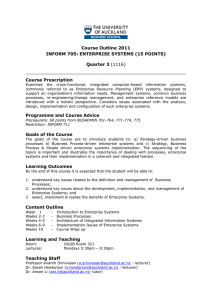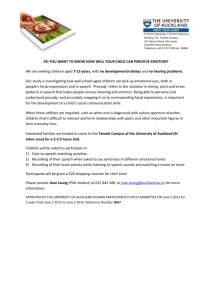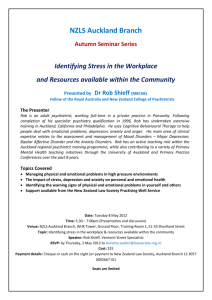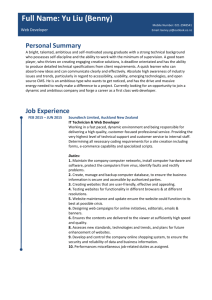Key Trends and Opportunities to 2020 – NZ
advertisement
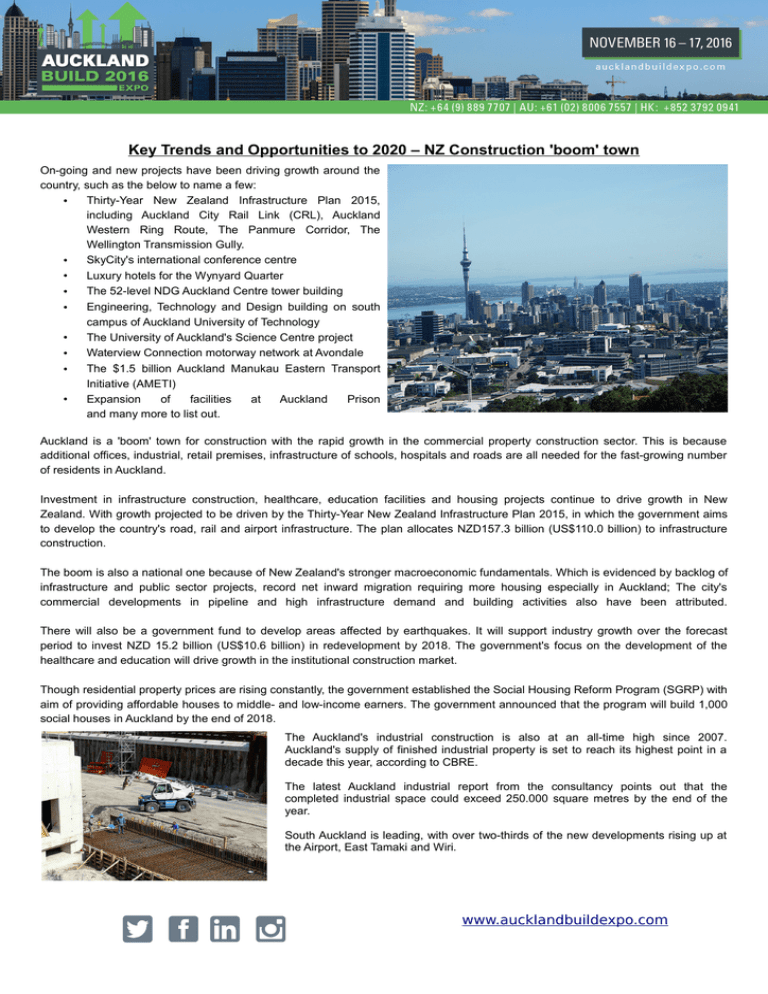
Key Trends and Opportunities to 2020 – NZ Construction 'boom' town On-going and new projects have been driving growth around the country, such as the below to name a few: Thirty-Year New Zealand Infrastructure Plan 2015, • including Auckland City Rail Link (CRL), Auckland Western Ring Route, The Panmure Corridor, The Wellington Transmission Gully. SkyCity's international conference centre • Luxury hotels for the Wynyard Quarter • The 52-level NDG Auckland Centre tower building • Engineering, Technology and Design building on south • campus of Auckland University of Technology The University of Auckland's Science Centre project • Waterview Connection motorway network at Avondale • The $1.5 billion Auckland Manukau Eastern Transport • Initiative (AMETI) Expansion of facilities at Auckland Prison • and many more to list out. Auckland is a 'boom' town for construction with the rapid growth in the commercial property construction sector. This is because additional offices, industrial, retail premises, infrastructure of schools, hospitals and roads are all needed for the fast-growing number of residents in Auckland. Investment in infrastructure construction, healthcare, education facilities and housing projects continue to drive growth in New Zealand. With growth projected to be driven by the Thirty-Year New Zealand Infrastructure Plan 2015, in which the government aims to develop the country's road, rail and airport infrastructure. The plan allocates NZD157.3 billion (US$110.0 billion) to infrastructure construction. The boom is also a national one because of New Zealand's stronger macroeconomic fundamentals. Which is evidenced by backlog of infrastructure and public sector projects, record net inward migration requiring more housing especially in Auckland; The city's commercial developments in pipeline and high infrastructure demand and building activities also have been attributed. There will also be a government fund to develop areas affected by earthquakes. It will support industry growth over the forecast period to invest NZD 15.2 billion (US$10.6 billion) in redevelopment by 2018. The government's focus on the development of the healthcare and education will drive growth in the institutional construction market. Though residential property prices are rising constantly, the government established the Social Housing Reform Program (SGRP) with aim of providing affordable houses to middle- and low-income earners. The government announced that the program will build 1,000 social houses in Auckland by the end of 2018. The Auckland's industrial construction is also at an all-time high since 2007. Auckland's supply of finished industrial property is set to reach its highest point in a decade this year, according to CBRE. The latest Auckland industrial report from the consultancy points out that the completed industrial space could exceed 250.000 square metres by the end of the year. South Auckland is leading, with over two-thirds of the new developments rising up at the Airport, East Tamaki and Wiri. www.aucklandbuildexpo.com Securing a pipeline of building talent for New Zealand The unsung heroes of the building industry, plumbers ensure that each home being built is connected properly. To keep up with construction demand around New Zealand, it’s clear that we need to have enough plumbers on tap. The latest figures show that a total of 760 additional jobs were created in the plumbing, gasfitting, and drainlaying sector in 2015. Employment in the sector grew faster than employment in the total economy (3.8% vs. 2.4%) last year. Looking to the future, this rate of growth needs to not only be maintained, but increased. It is forecast that nearly 8,000 new people are needed in the sector by 2020 to meet future employment growth. For the plumbing profession specifically, around 492 additional people are needed to fill jobs each year. Fortunately, the numbers of plumbing, gasfitting, and drainlaying trainees currently learning the trade are promising. Data from The Skills Organisation show that there was a rise in the total number of trainees in this sector from 2014 to 2015. Participation rates among Maori and Pasifika and female trainees also increased in 2015, ensuring a diverse pool of talent in the industry. Growing this diversity in the sector remains a key focus for The Skills Organisation, as it is the best way to maintain a solid pipeline of plumbers, gasfitters, and drainlayers in New Zealand. With the government recently pledging $14.4 million to apprenticeships in the 2016 Budget, The Skills Organisation and other industry training bodies now have the extra support to further promote training in key building sectors. There may still be a lot of work to be done to meet the demand for these professionals, but the recent numbers paint a picture of an industry with a stable future. The Skills Organisation is the industry training organisation overseeing plumbing, gasfitting, and drainlaying – along with 21 other industries – in New Zealand. Come and visit us at Auckland Build Expo 2016! The Timber industry is also ready to contribute! The timber industry reacts to the government's announced boost to home construction with the Housing Infrastructure Fund; timber professionals believe that has to have a timber focus. ''If we want that many houses to be built quickly, properly, and with sustainable materials, timber is the way to go. This is even more the case with the medium rise and high density dwelling construction which will be important in Auckland,'' Brian Stanley says, Woodco Chair. He further elaborated that timber is generally available and builders are inclined and are used to using it. Advantages being affordable and light; modern timber technology also gives great thermal retention and earthquake resistant qualities. ''A not insignificant factor is that using timber for construction is environmentally beneficial, since wooden buildings continue to lock up the carbon the tress have absorbed from the atmosphere in the first place.'' ''Timber ticks all the boxes and our industry is keen to talk with anyone in the construction business, architects, central and local government about how we might get on with the job.'' He says the scale and speed of house construction likely to result from the government initiative means builders in the targeted centres will want to work with materials and methods which have been well tested and are known to be reliable. www.aucklandbuildexpo.com World's biggest builder in town for $375m in contracts The world's biggest construction company, part of the giant China State Construction Engineering Corporation, China Construction New Zealand was announced to have won the $200 million contract to build the luxurious Park Hyatt Hotel in Auckland's Wynyard Quarter. CSCEC was named as the world's biggest builder by revenue in 2012 by The Economist. It now has revenue of about US$100 billion. It also planned to bid for the $175 million St James apartment tower contract for the new building on Queen St in CBD of Auckland. The company has been looking at the four-lane Penlink highway to Gulf Harbour of $387.8m, which the scheme has not been approved just yet. ''One of the issues holding back the development and construction market in New Zealand is high prices, so any additional competition we get is good. We do need to make sure competition is also bringing us quality and they're not taking short cuts with materials or labour.'' ''Construction costs have been high in New Zealand for a long time,'' Matt Paterson, Property Council acting chief executive said. The managing director of China Construction New Zealand, Timothy Yang, questioned PM John Key at a Chinese Chamber of Commerice Event. He questioned about the length of time it took to get infrastructure built, in particular to the Penlink project. And during the National Party conference in Christchurch, John Key announced a new $1 billion fund to fast-track infrastructure development by councils with high new housing demands. The councils currently eligible to access the fund for such things as water and roading development are Auckland, Hamilton, Tauranga, Christchurch and Queenstown. We have interviewed our Partner, Architecture+Women•NZ (A+W•NZ)! 1. Can you give a brief introduction to your association? Architecture+Women•NZ (A+W•NZ) brings together women trained in the field of architecture and seeks to raise their profile in the public realm through networking, events, publishing and the formation of policy. It’s free to join and while the organisation has serious intentions, participation is intended to be enjoyable as well as purposeful. Response by A+W•NZ, (Lynda Simmons). In the few years since it was set up, A+W•NZ has created a structure that provides guidance, discussion, visibility and positive role modelling for women and men alike through facilitating events and publications around a healthy reassessment of industry ‘norms’. The two core aims behind A+W•NZ are to promote visibility in the field of architectural practice, and to aim for an inclusive architectural practice culture. The A+W•NZ website hosts a growing database, currently at over 600 women, as well as research articles, news and events, and links to our social media platforms. Continued next page... www.aucklandbuildexpo.com 2. How people can support Architecture+Women•NZ and how Architecture+Women•NZ can support the architecture sector and construction industry? Anyone can support A+W•NZ simply by being involved – by joining the online database, staying connected, participating in the many events we hold, getting involved in research, and speaking up on issues of policy. If you do not meet the three criteria to join the online A+W•NZ database, anyone can register for the free monthly online newsletter from the home page of the website. Financial support is via donations, becoming a 'Friend of' A+W•NZ, or by direct sponsorship. For more details, see http://www.architecturewomen.org.nz/sponsors-donations. A+W•NZ supports the profession and the construction industry by ensuring the architectural community is engaged, active and informed. We hold lectures, exhibitions, engage in ongoing research and provide information on our online platforms. A+W•NZ reaches beyond those currently working in construction to those who may not be currently practicing, but like to stay connected. (For example those who are in suspension or who have left the profession for other design-related fields.) A+W•NZ have also supported the profession by raising money on behalf of other Charitable Trusts and groups such as the NZIA Venice Biennale team. 3. Can you provide us the percentage of women architect in New Zealand currently? What is your expectation of the trend in next 5 years? Why? Currently in NZ there is a 50:50 gender ratio across the three architecture schools, with an equal level of female and male graduates entering the profession for the last decade. (At Auckland University, there has been a steady increase of female students since 23% in 1983 to 55% in 2015.) The next stage where measurement is taken is at registration, which is currently 24% female, 76% male. While there are many women working in architectural practices, they tend not to get registered at the same rate as their male counterparts, and A+W•NZ believe that the architectural community must look at workplace structures and workplace culture to avoid losing so much valuable talent from the industry. Continued next page... www.aucklandbuildexpo.com 4. Are there any challenges for women architects to enter the sector? Why would these happen? Any barriers that previously existed in the universities have been removed via changes in employment policy over a 20year period, starting in the 1980s. The current diverse student population is slowly transferring into the workplace, where changes to policy are also beginning to be implemented. There is still very low representation of women at higher levels in architectural practices (1% nationally), however client demand for wider diversity, and research showing greater profits to companies with a broader representation of people at the director level, means that smart practices will look at removing any barriers they may have in place for the career development of some staff. 5. If so, what can the women professionals do to overcome the challenges? Be involved. Be visible. Be supportive of colleagues and speak up when fairness is not being practiced. A+W•NZ recognise that gender equity in New Zealand is very strong, and that our position of strength can be used to break down barriers for other diverse groups in architecture. It is hoped that discussions around gender, workplace culture and policy can have a wider effect on the visibility of many other diverse groups. The intention is for visibility and inclusiveness to apply to all who make their lives in architecture. 6. Coming to Auckland Build 2016 Expo, what are your expectations? Maintaining connections with the design and industry communities is important for all architects, and A+W•NZ are very happy to be involved at the Auckland Build 2016 Expo. As mentioned, one of our core aims is for women to be 'visible' in the industry, and we look forward to helping the many women involved in the industry in New Zealand to be seen. The other associations that are also on board with Auckland Build 2016 Expo! Elevating Work Platforms Association (EWPA) The primary objective of the EWPA is to promote best and safest practices for the use and maintenance of Elevating Work Platforms. We fulfill this objective by advocating for consistently high standards of EWP related training, and in areas of maintenance and certification. Specific initiatives have included: Training The Association has encouraged and endorsed the development of unit-standard based, quality assured EWP Operator courses by independent trainers. Such NZQA accredited operator training is now widely available. Maintenance & Inspection We have collaborated with Worksafe, ACC and others in the industry to define competence for EWP maintenance in a framework administered by the Certification Board for Inspection Personnel (CBIP). To achieve compliance and assure their insurance coverage, end users should only use EWPs that are certified by a CBIP inspector.In the future we intend to define a maintenance accreditation regime integrating the requirements set out in the Best Practice with systems paralleling those defined in the PECPER Regulations. Best Practice Definition The EWPA‘s current definition of best practice is based upon full compliance with the Best Practice for Mobile Elevating Work Platforms and it’s associated standards. In conjunction with regulatory authorities and standard-setting bodies we provide unambiguous interpretation of inspection and maintenance requirements. www.aucklandbuildexpo.com Māori and Pacific Trade Training:Auckland Māori and Pasifika Trades Training: Auckland is a partnership between Manukau Institute of Technology (MIT), Unitec, Te Wānanga o Aotearoa (TWoA), Hawkins, Ngāti Whātua Ōrākei Whai Maia, Building and Construction Industry Training Organisation (BCITO), The Skills Organisation, Competenz, Motor Industry Training Organisation (MITO), Connexis, Oceania Careers Academy, The Skills Alliance, The Solomon Group, Skills4Work and G&H Training. Māori and Pasifika Trades Training: Auckland provides trainees with a seamless pathway, supported and connected end to end, right into the heart of industry. For the trainee, MPTT: Auckland weaves together three threads that influence success: their community, trades training, and employers. Institute of Refrigeration Heating & Air Conditioning Engineers of New Zealand IRHACE is the professional body that looks after the interests of HVAC & R engineers. The benefits of joining IRHACE include access to advice and resources, free and discounted events, a regular Journal for the industry, and monthly updates on events and training. Its aims are to: • Promote the economic well-being and quality of life of our members, and of the refrigeration, heating, ventilation and air conditioning industries (our industry), and to improve the economic well-being and quality of life of every New Zealander • Represent and promote the business interests of our members who work in our industry • Advance and promote (including the use of standards) the technology used by and activities of those in our industry for the benefit of every New Zealander • Promote a high level of skill and design that our Members, Associates and Affiliates can follow (by developing Practice Guides, qualifications and other relevant industry sector New Zealand Standards as the Board thinks is appropriate for and relevant to our industry) • Provide a forum for our Members, Associates and Affiliates to discuss and share their knowledge and experience • Being a member of IRHACE looks good on your CV because it shows you take a professional interest in the latest trends and issues in your industry. Apprentices get membership at a significantly reduced rate, however if you don’t join you can still access a free newsletter and attend local trade night exhibitions. www.aucklandbuildexpo.com Climate Control Companies Association CCCA is the body that represents companies in the HVAC & R industries. Its purpose is to promote high standards of business and conduct for companies engaged in climate controlled environments. This includes: • • • • • • • Promoting education, good practice, and technology Promoting improvement of standards for the greater good of New Zealand Representing and promoting the interests of members, associates and affiliates Providing a forum for resolving disputes Promoting a high standard of workmanship and design Providing a discussion forum for the sharing of experience and knowledge Establishing a code of conduct Auckland Today Auckland Today is devoted entirely to highlighting the successful growth and development of business in the Auckland region. As a bi-monthly publication, the magazine has an audited circulation of 32,290 targeted at decision-makers in Auckland’s business landscape. Auckland Today captures the interest of those who are recognised as market leaders and contributors to New Zealand’s future. The magazine features articles which portray Auckland’s successful people, their businesses and their products or services. Features are not only informative and thought provoking, but also highlight the important elements of business strategy. Since Auckland Today’s inception in 1993, readers and advertisers alike have found the publication instrumental to the growth of their business. Cost effective, targeted advertising which gets the message across in detail and with accuracy is our way of working. Since 1980 thousands of companies have realised the benefits of advertising in these targeted publications. Construction Shows Construction Shows is an event and news information platform for the construction industry. Any business that has an interest in the construction arena and its trade shows can use the site to stay informed about important events in the construction calendar, such as conferences, exhibitions and trade fairs. Construction Shows offers a valuable resource for participants, exhibitors, visitors, session leaders and providers to trade shows. Lectura The publishing house LECTURA is the leading provider of market and price information for mobile machinery and equipment – the price guide is for over 90.000 machines. With help of LECTURA online system, the valuation of the used machines will be more comfortable. In only 5 steps you will get access to the valuation results including all technical details, new prices and an orientation of the used prices for buying and selling. www.aucklandbuildexpo.com All Supporting Partners of Auckland Build Expo 2016 Like our News? Follow us on our social media below for more! www.aucklandbuildexpo.com

